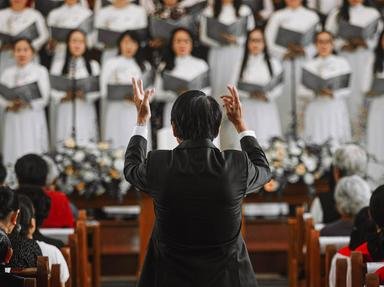Quiz Answer Key and Fun Facts
1. In 1644, the Westminster Assembly instituted the practice of "lining out" which was used extensively during the following century and is still practised in some churches today. This was intended to counter illiteracy and a shortage of psalters. What is "lining out"?
2. Hymns, as we know them, weren't sung in many English-speaking churches during the seventeenth century. Why was this?
3. Benjamin Keach popularised the singing of hymns among Baptist congregations. Publication of his first hymnbook, "Sacred Melody", in 1691, initially provoked some criticism. Which of these arguments was levelled against congregational hymn singing?
4. In the English-speaking world, one man is credited with developing the modern form of hymn. Who is this man, whose most famous work is probably "When I Survey the Wondrous Cross"?
5. German Lutheran hymn writers did not have the same hang-ups as their English counterparts. Not only had Luther himself advocated the use of popular tunes but they also had one of the world's greatest composers writing original music or adapting existing tunes. Who was this composer?
6. In non-conformist churches, hymns were seen as a useful teaching aid as well as a means of worship. Another great hymn writer was Philip Doddridge, an academic and non-conformist minister, who wrote hundreds of hymns to "back-up" his sermons. Which of these gospel classics did he write?
7. Samuel Crossman (1623-1683) was an English clergyman who, at one time, simultaneously pastored an Anglican and a Puritan congregation. What is the name of his most famous hymn, that was "sampled" by Coldplay on their 2005 "X&Y" album?
8. Which of the following seventeenth century writers, the author of "Awake, My Soul, and With the Sun" and "Praise God from Whom All Blessings Flow", was the stepbrother-in-law of Isaak "The Compleat Angler" Walton and was imprisoned in the Tower of London?
9. As well as helping to found the Methodist movement, Charles Wesley was also a prolific hymn writer, amassing thousands of hymns. One of his most famous, entitled "Where Shall My Wondering Soul Begin", was written in May 1738. What is the personal significance of this hymn?
10. After the deposing of James II in 1689, many Catholics went into exile in France. A favourite Christmas carol originated from these circles. It dates from the 1740s and was accompanied by the title "A Prayer for James" - James being James III, the "Old Pretender". What is the name of this carol?
Source: Author
glendathecat
This quiz was reviewed by FunTrivia editor
agony before going online.
Any errors found in FunTrivia content are routinely corrected through our feedback system.
